Abstract
OBJECTIVE: The present study examined the effects of gender-matching and racial self-labeling on the paranoid symptoms of African-American men with severe mental illness. It was hypothesized that gender matching would: 1) reduce self-reports of both interpersonal and cultural paranoia in these male participants with severe mental illness, and 2) the gender effect would be strongest among those patients who racially self-label as African-American. METHOD: One-hundred-twenty-four African-American male psychiatric patients were interviewed by a male or female black psychologist. A multivariate analysis of variance (MANOVA) was conducted with the Fenigstein Paranoia Scale (FPS) and Cultural Mistrust Inventory (CMI) as dependent variables, and the male gender-matched group (0=no, 1=yes) and racial self-labeling as the independent variables controlling for age; education; never married (0=no, 1=yes); diagnosis of schizophrenia (0=no, 1=yes); need for approval; self-esteem; and the scales of Distrust, Perceived Hostility of Others, and False Beliefs and Perceptions from the Psychiatric Epidemiology Research Interview. RESULTS: There was a significant main effect for male gender-matching on the FPS. Participants in the male gender-matched group scored lower than the other group on the FPS. For the CMI, there was a significant interaction of male gender match by racial self-labeling effect. Participants who were male gender-matched and self-labeled as African-American reported the highest scores on the CMI. CONCLUSION: The findings provide partial support for the hypotheses. Both gender-matching and racial identity together may be important considerations for black males needing mental health services.
Full text
PDF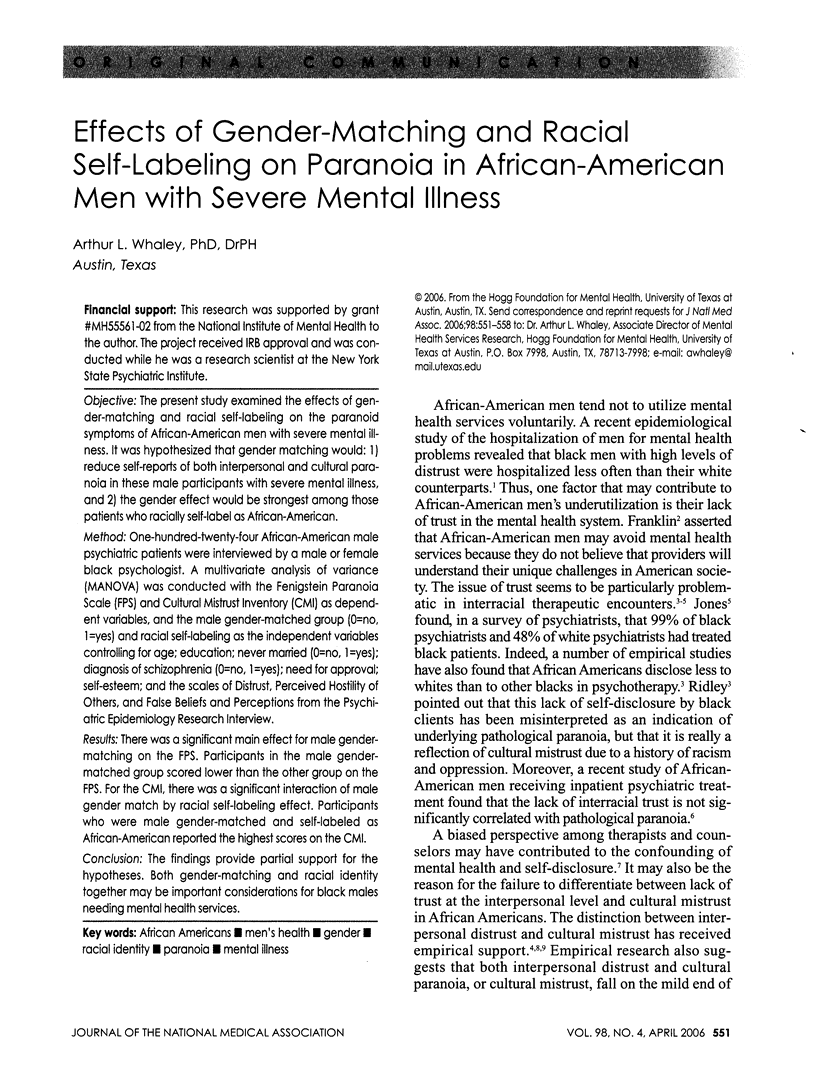
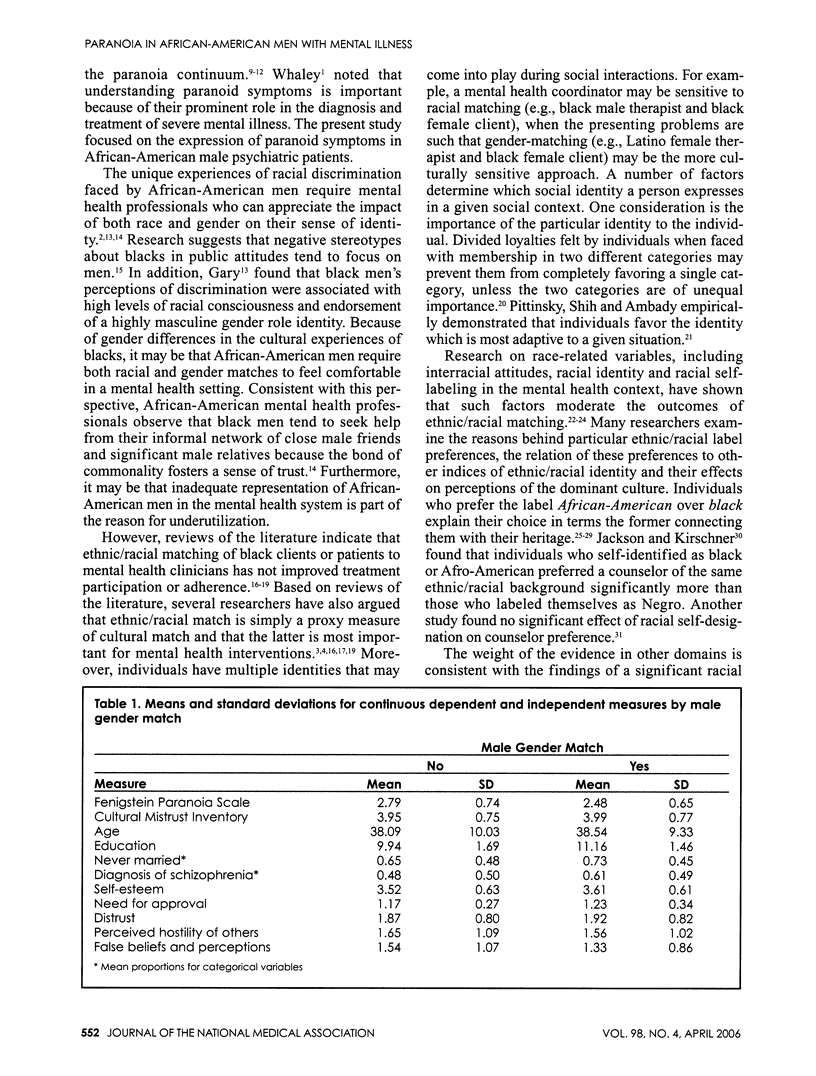
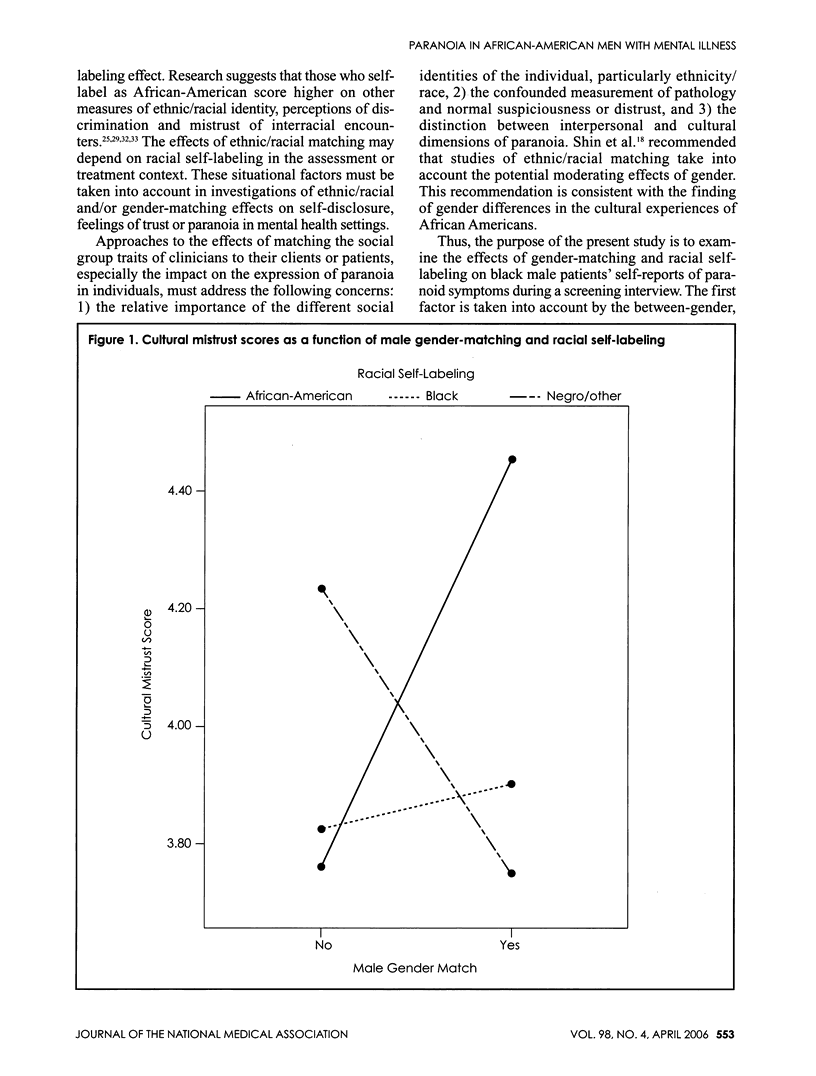
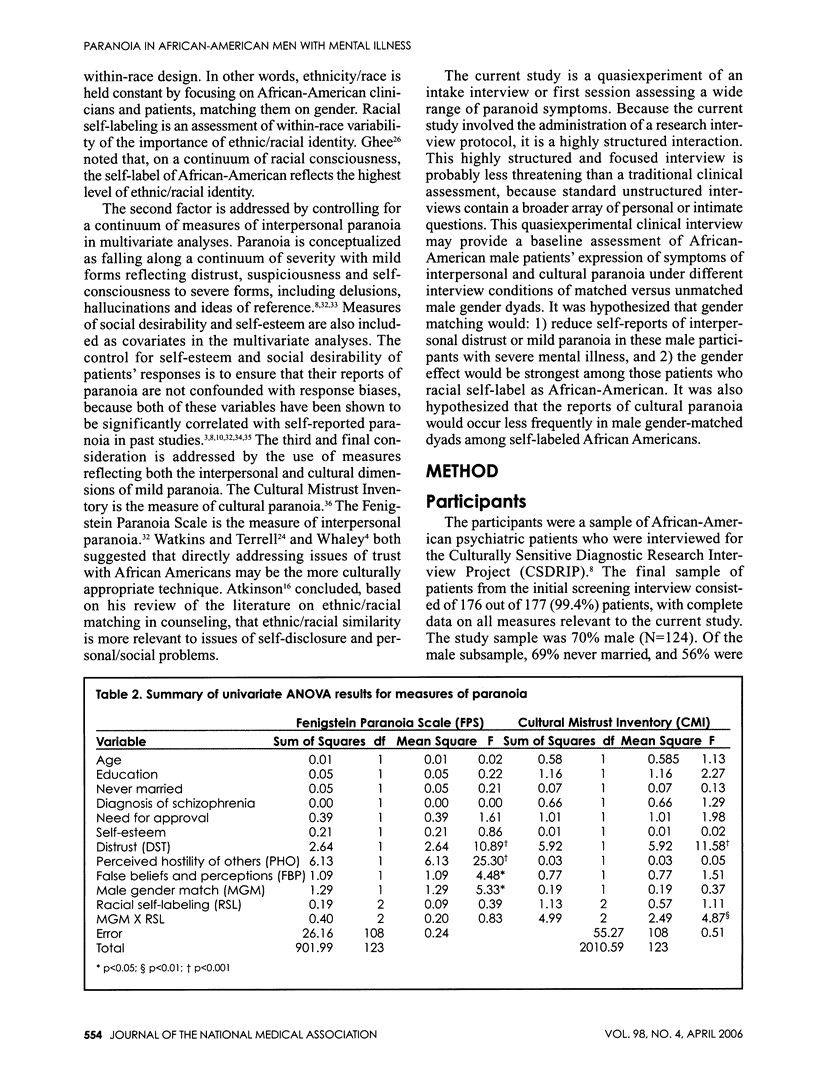

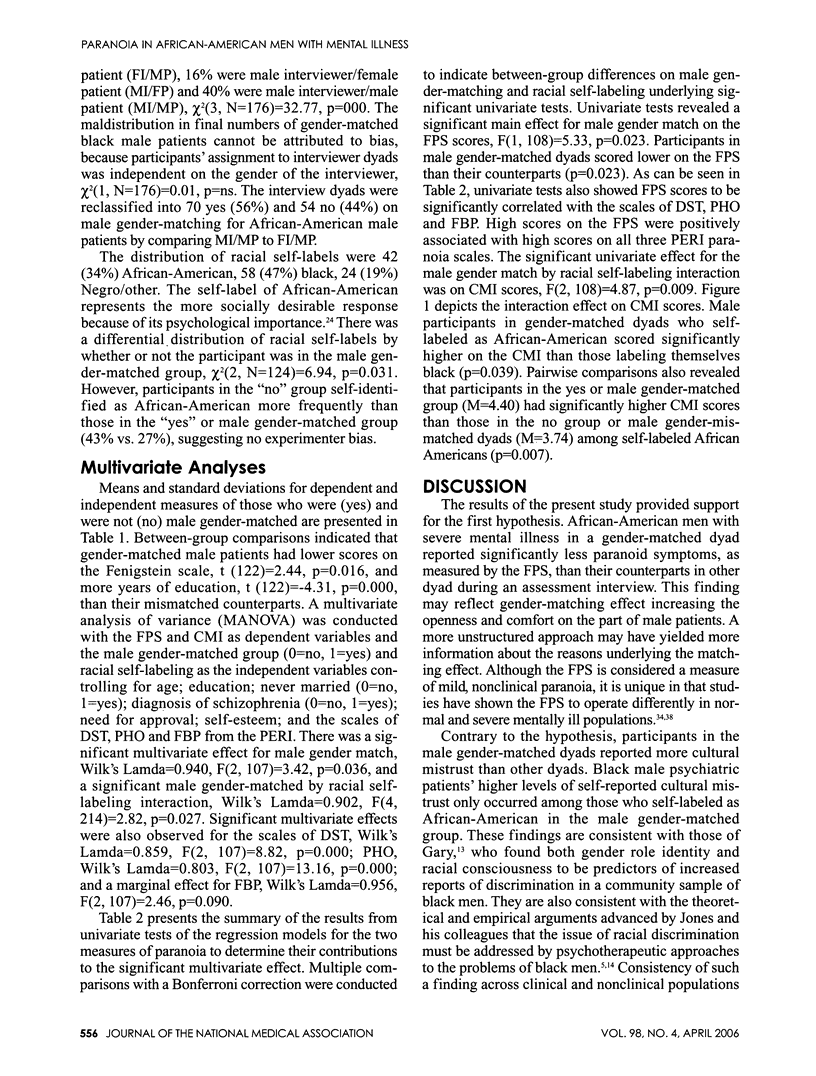
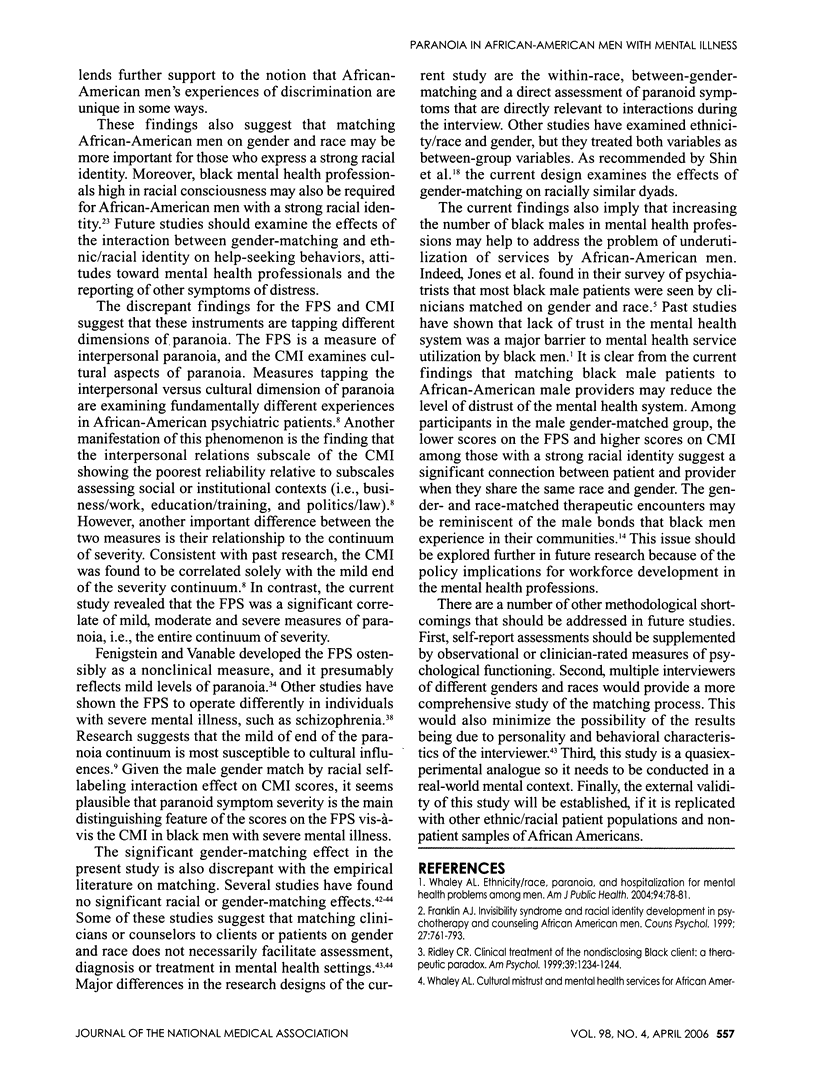
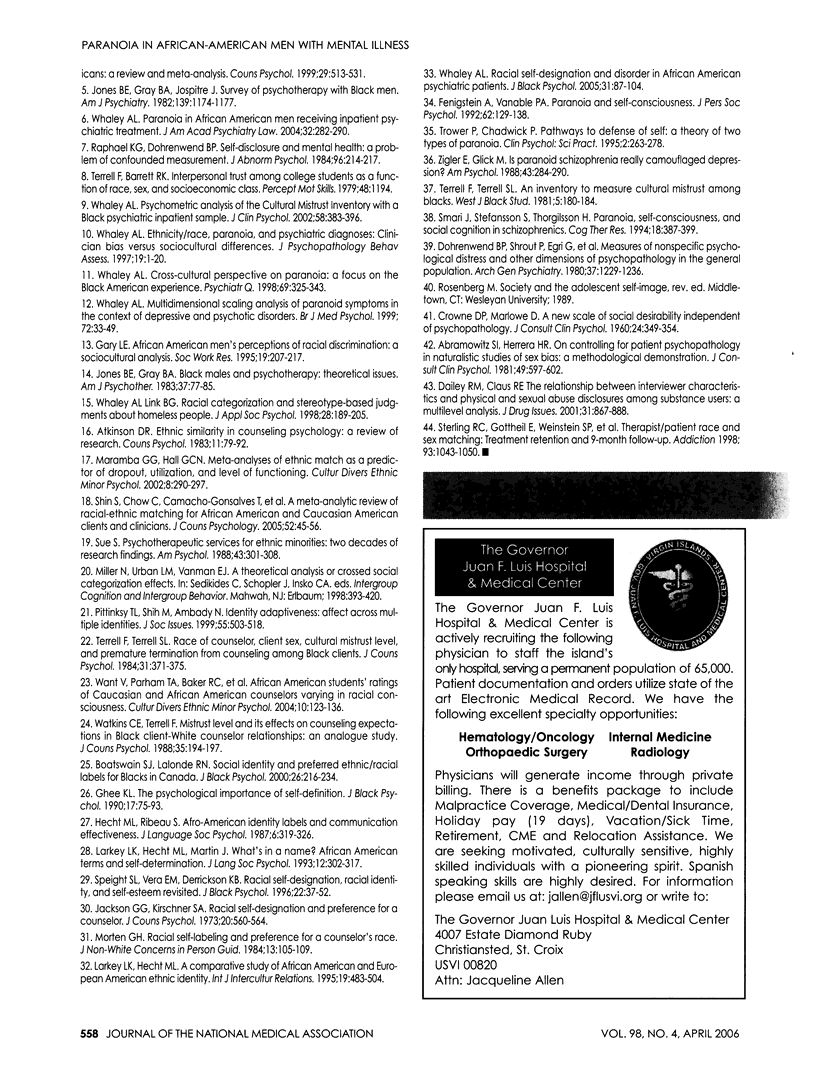
Selected References
These references are in PubMed. This may not be the complete list of references from this article.
- Abramowitz S. I., Herrera H. R. On controlling for patient psychopathology in naturalistic studies of sex bias: a methodological demonstration. J Consult Clin Psychol. 1981 Aug;49(4):597–603. doi: 10.1037//0022-006x.49.4.597. [DOI] [PubMed] [Google Scholar]
- CROWNE D. P., MARLOWE D. A new scale of social desirability independent of psychopathology. J Consult Psychol. 1960 Aug;24:349–354. doi: 10.1037/h0047358. [DOI] [PubMed] [Google Scholar]
- Dohrenwend B. P., Shrout P. E., Egri G., Mendelsohn F. S. Nonspecific psychological distress and other dimensions of psychopathology. Measures for use in the general population. Arch Gen Psychiatry. 1980 Nov;37(11):1229–1236. doi: 10.1001/archpsyc.1980.01780240027003. [DOI] [PubMed] [Google Scholar]
- Fenigstein A., Vanable P. A. Paranoia and self-consciousness. J Pers Soc Psychol. 1992 Jan;62(1):129–138. doi: 10.1037//0022-3514.62.1.129. [DOI] [PubMed] [Google Scholar]
- Jones B. E., Gray B. A. Black males and psychotherapy: theoretical issues. Am J Psychother. 1983 Jan;37(1):77–85. doi: 10.1176/appi.psychotherapy.1983.37.1.77. [DOI] [PubMed] [Google Scholar]
- Jones B. E., Gray B. A., Jospitre J. Survey of psychotherapy with black men. Am J Psychiatry. 1982 Sep;139(9):1174–1177. doi: 10.1176/ajp.139.9.1174. [DOI] [PubMed] [Google Scholar]
- Maramba Gloria Gia, Hall Gordon C. Nagayama. Meta-analyses of ethnic match as a predictor of dropout, utilization, and level of functioning. Cultur Divers Ethnic Minor Psychol. 2002 Aug;8(3):290–297. doi: 10.1037/1099-9809.8.3.290. [DOI] [PubMed] [Google Scholar]
- Raphael K. G., Dohrenwend B. P. Self-disclosure and mental health: a problem of confounded measurement. J Abnorm Psychol. 1987 Aug;96(3):214–217. doi: 10.1037//0021-843x.96.3.214. [DOI] [PubMed] [Google Scholar]
- Ridley C. R. Clinical treatment of the nondisclosing black client. A therapeutic paradox. Am Psychol. 1984 Nov;39(11):1234–1244. doi: 10.1037//0003-066x.39.11.1234. [DOI] [PubMed] [Google Scholar]
- Sterling R. C., Gottheil E., Weinstein S. P., Serota R. Therapist/patient race and sex matching: treatment retention and 9-month follow-up outcome. Addiction. 1998 Jul;93(7):1043–1050. doi: 10.1046/j.1360-0443.1998.93710439.x. [DOI] [PubMed] [Google Scholar]
- Sue S. Psychotherapeutic services for ethnic minorities. Two decades of research findings. Am Psychol. 1988 Apr;43(4):301–308. doi: 10.1037//0003-066x.43.4.301. [DOI] [PubMed] [Google Scholar]
- Want Valerie, Parham Thomas A., Baker Richard C., Sherman Mark. African American students' ratings of Caucasian and African American counselors varying in racial consciousness. Cultur Divers Ethnic Minor Psychol. 2004 May;10(2):123–136. doi: 10.1037/1099-9809.10.2.123. [DOI] [PubMed] [Google Scholar]
- Whaley A. L. Cross-cultural perspective on paranoia: a focus on the black American experience. Psychiatr Q. 1998 Winter;69(4):325–343. doi: 10.1023/a:1022134231763. [DOI] [PubMed] [Google Scholar]
- Whaley A. L. Multidimensional scaling analysis of paranoid symptoms in the context of depressive and psychotic disorders. Br J Med Psychol. 1999 Mar;72(Pt 1):33–49. doi: 10.1348/000711299159808. [DOI] [PubMed] [Google Scholar]
- Whaley Arthur L. Ethnicity/race, paranoia, and hospitalization for mental health problems among men. Am J Public Health. 2004 Jan;94(1):78–81. doi: 10.2105/ajph.94.1.78. [DOI] [PMC free article] [PubMed] [Google Scholar]
- Whaley Arthur L. Paranoia in African-American men receiving inpatient psychiatric treatment. J Am Acad Psychiatry Law. 2004;32(3):282–290. [PubMed] [Google Scholar]
- Whaley Arthur L. Psychometric analysis of the cultural mistrust inventory with a Black psychiatric inpatient sample. J Clin Psychol. 2002 Apr;58(4):383–396. doi: 10.1002/jclp.1150. [DOI] [PubMed] [Google Scholar]
- Williams James C., Jr, Zarse Chad A., Jackson Molly E., Witzmann Frank A., McAteer James A. Variability of protein content in calcium oxalate monohydrate stones. J Endourol. 2006 Aug;20(8):560–564. doi: 10.1089/end.2006.20.560. [DOI] [PMC free article] [PubMed] [Google Scholar]
- Zigler E., Glick M. Is paranoid schizophrenia really camouflaged depression? Am Psychol. 1988 Apr;43(4):284–290. doi: 10.1037//0003-066x.43.4.284. [DOI] [PubMed] [Google Scholar]


